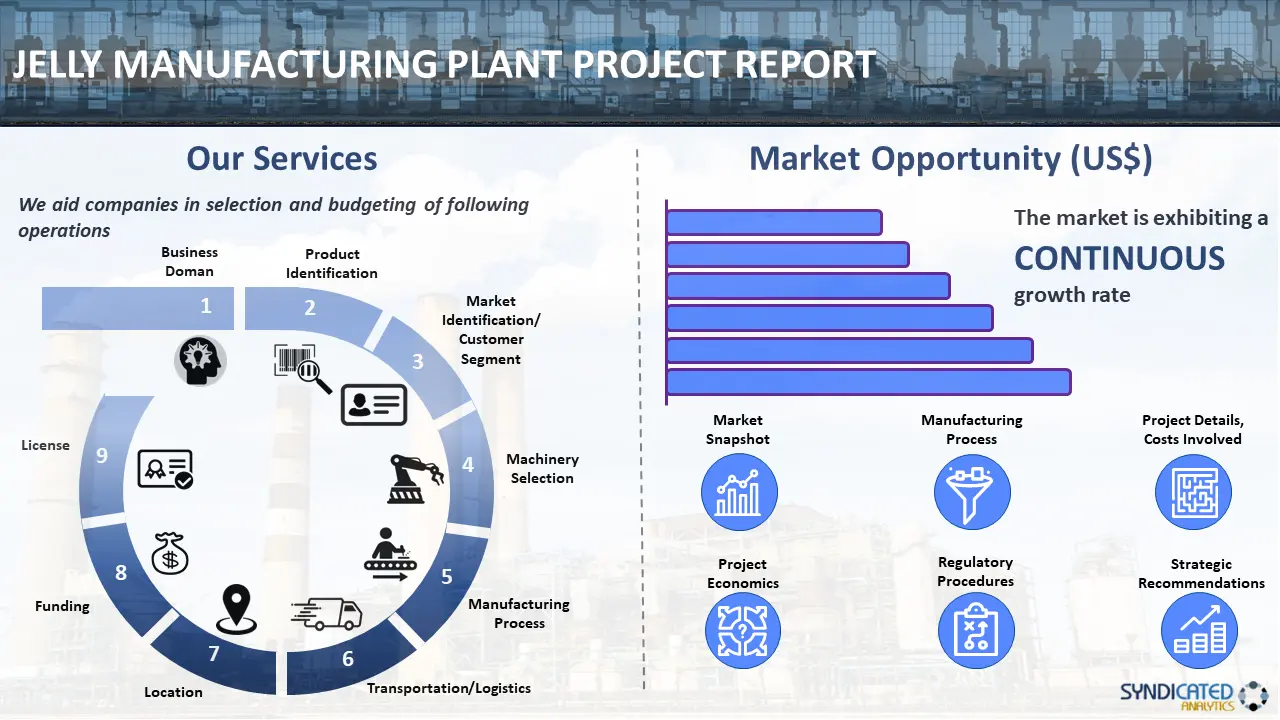
Jelly Manufacturing Plant Project Report 2025 Edition
Report Coverage: Industry Analysis (Market Performance, Segments, Price Analysis, Outlook), Detailed Process Flow (Product Overview, Unit Operations, Raw Materials, Quality Assurance), Requirements and Cost (Machinery, Raw Materials, Packaging, Transportation, Utility, Human Resource), Project Economics (Capital Investments, Operating Costs, Profit Projections, Financial Analysis, Revenue), and Investment Opportunities
Report Overview:
The new report conducted by Syndicated Analytics, titled "Jelly Manufacturing Plant Project Report 2025 Edition: Industry Analysis (Market Performance, Segments, Price Analysis, Outlook), Detailed Process Flow (Product Overview, Unit Operations, Raw Materials, Quality Assurance), Requirements and Cost (Machinery, Raw Materials, Packaging, Transportation, Utility, Human Resource), Project Economics (Capital Investments, Operating Costs, Profit Projections, Financial Analysis, Revenue), and Investment Opportunities," offers a comprehensive guide for establishing a manufacturing plant in the jelly industry. It encompasses a wide-ranging market overview and delves into specific details such as unit operations, raw material requirements, utility needs, infrastructure prerequisites, machinery and technology specifications, workforce demands, packaging prerequisites, transportation logistics, and more.
Furthermore, this report delivers extensive insights into project economics, including capital investments, project financing, operating costs, income and expenditure forecasts, fixed versus variable expenses, direct and indirect outlays, expected return on investment (ROI), net present value (NPV), profit and loss analysis, and comprehensive financial assessment.

Market Analysis
| Current Demand for Jelly | The report evaluates the existing global demand for jelly. |
| Growth Prospects and Trends | The study delves into the growth prospects and emerging trends within the jelly market, providing insights to guide strategic decision-making. |
| Leading Segment and Regional Analysis | This study presents a concise overview of the key segments and regional influence in the jelly market, providing a comprehensive view of the industry's overall landscape. |
| Competitive Landscape | An analysis of the competitive landscape highlights key players in the jelly manufacturing industry, shedding light on their strategies and market positioning. |
A. Introduction
Jelly is a delightful and versatile food product known for its sweet, translucent appearance and smooth, gel-like texture. It is primarily made from fruit juice or puree, sugar, and pectin, a natural gelling agent found in fruits. Its manufacturing process begins with the extraction of fruit juice, which is then mixed with sugar to create a sweet base. Pectin is added to this mixture, which is then heated until it reaches a gel-like consistency. The result is a flavorful and visually appealing spread that can be used in a variety of culinary applications. One of the key attractions of jelly is its diverse range of flavors, with popular choices including strawberry, grape, raspberry, and orange. These fruit flavors are often complemented by a touch of tartness, creating a balanced and refreshing taste. Jelly is a versatile ingredient in both sweet and savory dishes. It can be spread on toast, used as a filling for pastries, or incorporated into desserts like cakes and tarts. Additionally, it pairs wonderfully with cheese, making it a staple on cheese boards and charcuterie platters. Moreover, its transparent and jewel-like appearance makes it an attractive garnish for desserts and cocktails.
B. Market Trends/Drivers
The global jelly market is influenced by a diverse set of drivers, such as the widespread popularity of jellies and jams as breakfast condiments and toppings. In line with this, the growing trend towards natural and fruit-based products has boosted the demand for organic and low-sugar jellies, aligning with health-conscious consumer preferences, further bolstering the market growth. Additionally, the convenience factor associated with single-serve jelly packets has driven sales in on-the-go consumption scenarios, which is fueling the market growth. Additionally, the expansion of the bakery and confectionery industry has created new avenues for the inclusion of jellies in various desserts and baked goods, spurring the market growth. Another crucial factor is the global reach of international cuisines, which has also contributed to the diversity of jelly flavors and applications, catering to a broader consumer base. Moreover, packaging innovations, such as squeezable bottles and resealable containers, have enhanced the user experience and attracted consumers, which is facilitating the market growth. Furthermore, the role of e-commerce and online grocery platforms has made it easier for consumers to access a wide variety of jelly products, driving the market expansion. Apart from this, marketing campaigns focused on nostalgia and childhood memories associated with jelly consumption have resonated with consumers, which is stimulating the market growth.
The report provides a techno-commercial roadmap for setting up a jelly manufacturing plant. The study covers all the requisite aspects that one needs to know while making a foray into the jelly industry. This ranges from macro overview of the market to micro details of the industry performance, key success and risk factors, manufacturing requirements, project cost, project economics, expected returns on investment, profit margins, etc. This report is a must-read for entrepreneurs, investors, researchers, consultants, business strategists, and all those who have any kind of stake in the jelly industry.
Market Coverage:
| Current Demand for Jelly | The report evaluates the existing global demand for jelly. |
| Growth Prospects and Trends | The study delves into the growth prospects and emerging trends within the jelly market, providing insights to guide strategic decision-making. |
| Leading Segment and Regional Analysis | This study presents a concise overview of the key segments and regional influence in the jelly market, providing a comprehensive view of the industry's overall landscape. |
| Competitive Landscape | An analysis of the competitive landscape highlights key players in the jelly manufacturing industry, shedding light on their strategies and market positioning. |
Project Feasibility
| Technical Feasibility | The study outlines the intricacies of jelly manufacturing, outlining the necessary equipment and technological requirements. A clear description of the manufacturing process is provided. |
| Financial Feasibility | The report presents an in-depth financial analysis, including the initial investment required, income and profit projections. These financial insights aim to assist potential investors in assessing the viability of the project. |
| Environmental and Regulatory Considerations | The report also discusses the environmental and regulatory aspects associated with jelly production, ensuring that the project aligns with sustainability and compliance standards. |
Project Implementation
| Location Selection | Choosing the optimal location for the manufacturing plant is crucial. This section explores location-based factors impacting the project's success. |
| Plant Design and Layout | Detailed plant design and layout plans are presented, emphasizing efficient production processes and workspace ergonomics. |
| Procurement of Raw Materials | An overview of the procurement process for raw materials necessary for jelly production is provided, ensuring a smooth supply chain. |
| Production Process | An explanation of the jelly production process is provided in the study, from raw material input to the final product, highlighting key stages and quality control measures. |
| Quality Control Measures | Stringent quality control measures are outlined to ensure the production of high-quality jelly. |
Risk Analysis
| Identification of Potential Risks | Potential risks associated with the project are identified, allowing for proactive risk management strategies. |
| Risk Mitigation Strategies | The report proposes risk mitigation strategies to minimize the impact of identified risks on the project's success. |
Seeking a Tailored Project Report?
While we have endeavored to create a comprehensive report, we acknowledge that each stakeholder may possess unique requirements. In light of this, we offer the option to customize the report to align with your specific needs. You can convey your business specifications to our consultants, and we will furnish you with a personalized scope tailored precisely to your requirements. Some of the common customizations that our clients often request include:
- Tailoring the report to suit the country/region where you intend to establish your plant.
- Adapting the manufacturing capacity of the plant to meet your specific needs.
- Customizing machinery suppliers and costs to align with your requirements.
- Incorporating any additional elements into the existing scope as per your specifications.
Report Scope:
| Features | Details |
|---|---|
| Currency | US$ (Information can also be provided in the local currency) |
| Pricing and Purchase Options | Single User License: US$ 3450 Five User License: US$ 4450 Corporate User License: US$ 5450 |
| Customization Scope | The report can also be customized based on the requirements of the customer. |
| Post-Sale Analyst Support | 12-14 Weeks |
| Delivery Format | PDF and Excel through email (We can also provide the editable version of the report in PPT/Word format on special request) |
Questions Addressed in the Report:
- What has been the performance of the jelly market to date, and what are the projections for its future growth?
- How is the jelly market segmented globally?
- How is the jelly market distributed across various regions?
- What trends are observed in the pricing of different feedstocks within the jelly industry?
- What constitutes the structure of the jelly industry, and who are its major stakeholders?
- What key operations are necessary for manufacturing jelly?
- How much land is required to establish a jelly manufacturing plant?
- What is the planned layout for a jelly manufacturing plant?
- What equipment is essential for starting a jelly manufacturing plant?
- What materials are needed to begin production in a jelly manufacturing plant?
- What are the packaging necessities for a jelly manufacturing plant?
- What transportation logistics are required for a jelly manufacturing plant?
- What utilities are needed to operate a jelly manufacturing plant?
- What staffing is necessary for the operation of a jelly manufacturing plant?
- What are the estimated infrastructure costs for establishing a jelly manufacturing plant?
- What initial investments are necessary for setting up a jelly manufacturing plant?
- What will the ongoing operational expenses be for a jelly manufacturing plant?
- How should be the pricing structure for the final product in the jelly industry?
- What are the expected revenues and costs associated with running a jelly manufacturing plant?
- How long will it take for the plant to reach the break-even point?
- What are the forecasted profits from establishing a jelly manufacturing plant?
- What factors determine success and what risks exist in the jelly industry?
- What regulations must be complied with to establish a jelly manufacturing plant?
- What certifications are necessary to operate a jelly manufacturing plant?
Why Choose Syndicated Analytics:
- Our reports offer valuable insights to stakeholders, enabling them to make informed business decisions confidently.
- We maintain a robust network of consultants and domain experts spanning over 100 countries across North America, Europe, Asia Pacific, South America, Africa, and the Middle East.
- Our extensive database includes equipment, and raw material suppliers from major continents, ensuring comprehensive coverage.
- We diligently track and update critical factors such as land costs, raw material costs, construction costs, utility expenses, labor costs, and more, across more than 100 countries worldwide.
- Syndicated Analytics is the trusted partner of choice for leading corporations, governments, and institutions globally. Our clientele ranges from small startups to Fortune 500 companies.
- Our dedicated in-house team comprises experts in various fields, including engineers, statisticians, modeling specialists, chartered accountants, architects, and more. They play a pivotal role in developing, expanding, and optimizing sustainable manufacturing facilities worldwide.
Purchase Options
Ask For Customization
Personalize this research
Triangulate with your own data
Get data as per your format and definition
Gain a deeper dive on a specific application, geography, customer or competitor
Any level of personalization
Get in Touch
Call us on
US: +1-213-316-7435
Uk: +44-20-8040-3201
Drop us an email at
sales@syndicatedanalytics.com